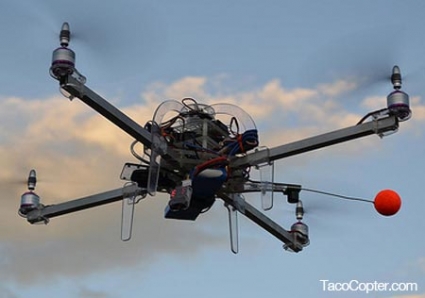Future Now
The IFTF Blog
TacoCopter and the Imminent Age of Drones
We’re at the ground floor of the Drone Age.
That was the message from Star Simpson, who stopped by the Institute yesterday to talk about TacoCopter, her in-joke turned viral juggernaut. The idea behind TacoCopter is relatively simple, but irresistibly futuristic: order tacos from your smartphone, and your friendly neighborhood unmanned drone will deliver them to your exact GPS coordinates within minutes. Star created tacocopter.com in 2011 as a joke to a friend, then promptly moved on to other projects. It wasn’t until March of 2012 that the popular blog Hacker News discovered her site, at which point every 21st century media outlet jumped onto the story of the business that would change restaurants forever. It didn’t seem to matter whether TacoCopter was real or not - it was an idea whose time had come.
It’s not that Star doesn’t have the chops to make TacoCopter a reality. A maker and long-time member of the hobbyist drone community, she’s created many successful projects that blend technology into human lives in novel and disruptive ways. While working at the MIT Media Lab, she created wearable electronics that use biofeedback sensors to detect posture, and designed expressive robots to help assist with weight loss. She’s even built a working TacoCopter prototype, and as we watched the video - the quadrotor gently lowering a bag of moist tortillas to the ground - it’s hard not to believe that the age of flying robots has arrived.
The problem, Star points out, is that laws haven’t kept pace with the technology. Drone activity is strictly regulated by the FAA, and commercial use is currently prohibited. The FAA does provide exemptions for some businesses in the form of Special Airworthiness Certificates, but the list of SAC recipients reveals them to be mostly government agencies, defense contractors and universities. Some police departments are already using camera-equipped drones for aerial surveillance, meaning we may have to pass through Blade Runner before we get to the promised land of the Internet of Tacos.
In the meantime, Star is doing everything she can to promote the usefulness of drones outside the “flying alien robot” perception they often create. While the current incarnation of predator drones strike fear into many, she equates the long-term technology more with self-driving cars than intelligent missiles. Off-the-shelf quadrotors are currently available for anything from $500 to tens of thousands of dollars, and are being used by cinematographers and real estate agents eager for a flying camera rig. In the next decade, Star predicts they will become cheaper and quieter, will travel further distances on a single charge (current consumer quadrotors can fly about five miles round trip), and will adapt more on-board abilities and contextual controls. There are a lot of legislative conversations to be had about how we’re going to manage this new world of flying robots, but TacoCopter provides a friendly vision of what that world might entail - even if it is still flying just a little out of reach.




